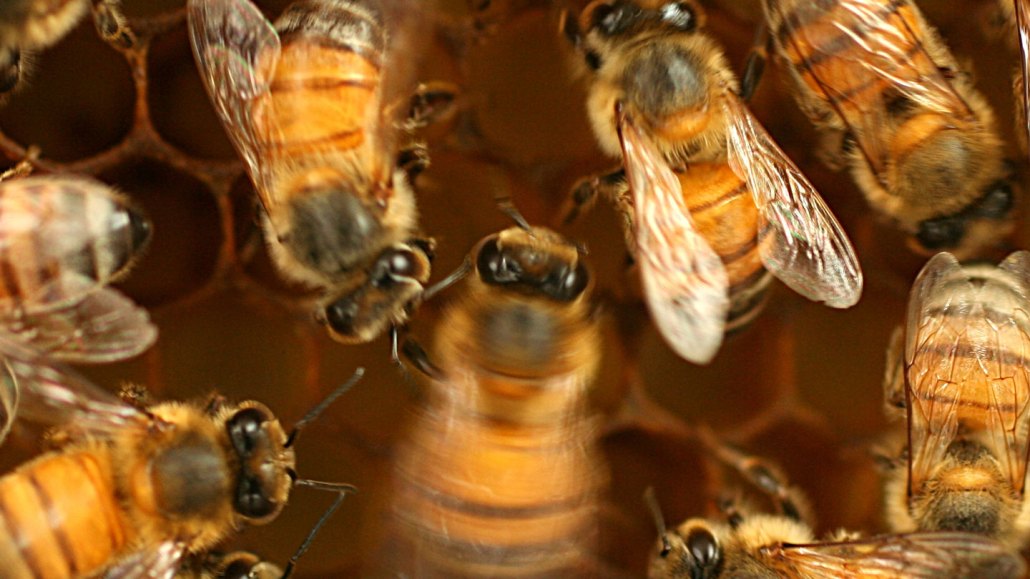
A novel test of honeybees’ waggle dancing shows that they can learn to do it better.
Heather Broccard Bell
In a castaway test setup, groups of young honeybees figuring out how to forage on their own start waggle dancing spontaneously — but badly.
Waggling matters. A honeybee’s rump-shimmy runs and turning loops encode clues that help her colony mates fly to food she has found, sometimes kilometers away. However, five colonies in the new test had no older sisters or half-sisters around as role models for getting the dance moves right.
Still, dances improved in some ways as the youngsters wiggled and looped day after day, reports behavioral ecologist James Nieh of the University of California, San Diego. But when waggling the clues for distance information, Apis mellifera without role models never did match the timing and coding in normal colonies where young bees practiced with older foragers before doing the main waggle themselves.
The youngsters-only colonies thus show that social learning, or the lack of it, matters for communicating by dance among honeybees, Nieh and an international team of colleagues say in the March 10 Science. Bee waggle dancing, a sort of language, turns out to be both innate and learned, like songbird or human communication.
The dance may appear simple in a diagram, but executing it on expanses of honeycomb cells gets challenging. Bees are “running forward at over one body length per second in the pitch black trying to keep the correct angle, surrounded by hundreds of bees that are crowding them,” Nieh says.
Beekeepers and biologists know that some kinds of bees can learn from others of their kind — some bumblebees even tried soccer (SN: 2/23/17). But when it comes to waggle dancing, “I think people have assumed it’s genetic,” Nieh says. That would make this fancy footwork more like the chatty but innate communications of cuttlefish color change, for instance. The lab bee-castaway experiments instead show a nonhuman example of “social learning for sophisticated communication,” Nieh says.
Testing for social learning took some elaborate beekeeping. At an apiary research center in Kunming, China, researchers put thousands of nearly grown-up honeybees (at what’s called the purple-eyed pupae stage) into incubators and then collected the brand-new winged adults when they emerged.
These youngsters went into five weirdly populated colonies of same-age worker newbies. Each colony got a queen, who would lay eggs but not leave the colony to forage. Food had to come from the young workforce, with no older, experienced foragers buzzing in and dancing the locations of flowers.
In waggle dancing, foraging bees have to master not only the moves but the obstacles of the honeycomb dance floor. A cell may be empty. “It’s just the edges to hang on to…. It would be easy to stumble,” Nieh says. Unlike commercial hives with manufactured uniform honeycomb cells, natural combs “are very irregular,” he says. “Along the edges, they get a bit crazy and rough.”
Dances on these treacherous surfaces encode the food’s direction in the angle a dancer waggles across the comb (measured relative to gravity). Duration of waggling bout gives a clue on how far away the bonanza is.
The five colonies of castaways were left to figure out dancing on their own, in contrast to five other colonies in the apiary with a natural mix. Early in the experiments, researchers recorded and analyzed the first dances of five bees from each hive.
Even in the mixed-age hives, the dancers didn’t get the angle perfect every time. The extremes in a set of six waggle runs might differ by a bit more than 30 degrees. The castaway hives, though, had far more trouble at first. Two of the five castaway dancers’ angles veered more than 50 degrees apart, and one poor bee strayed more than 60 degrees in six repeats.
As the castaways got more experience, they got better though. Repeating the test with the same marked bees a few weeks later near the end of their lives found them angling about as well as dancers in a normal hive.
What the castaways didn’t change much were dance features that encode distance to food. Researchers had set up the hives so that all would have the same experience of flying the distance to a feeder. Yet castaway bees persisted in dancing as if it were farther.
They gave more rump wags per waggle run (closer to five wags) than bees from mixed-age hives (more like 3.5 wags). The youngsters also took longer on each run.
Evidence like this foraging study is “indeed accumulating for the importance of learning (whether individual or social) in the complex behaviors of bees,” insect ecophysiologist Tamar Keasar of the University of Haifa in Israel says in an email. In her own work, she sees bees learning to extract food from complicated flowers. Bees aren’t, after all, just little automatons with wings.






